White Spaces Unveiled: Investigating the Restorative Potential of Environmentally Perceived Characteristics in Urban Parks during Winter
Abstract
:1. Introduction
2. Materials and Methods
2.1. Study Sites
2.2. Measuring Tool
2.2.1. Landscape
2.2.2. Soundscape
2.2.3. Nature Exposure
2.3. Procedure of the Experiment
2.4. Data Analysis
2.5. Selection of Subjects
3. Results
3.1. Reliability and Validity
3.2. Perceived Recovery Benefit Results for Different Path Types
3.2.1. Descriptive Statistics of Landscape Characteristics
3.2.2. Descriptive Statistics of Soundscape Characteristics
3.3. Restorative Results for Landscape and Soundscapes
3.3.1. Restorative Comparison Results
3.3.2. Restorative Differences with Different Paths
3.4. Perceived Recovery Correlation Analysis
3.4.1. Landscape Elements and Restorative
3.4.2. Soundscape Elements and Restorativeness
3.5. Relationship between Exposure Duration and Restorativeness
3.6. The Mediating Role of Soundscape Perceived Recovery
3.7. Comparison of Results for Different Genders
4. Discussion
4.1. Snow Is a Restorative Landscape Element
4.2. Differences in Winter Plant Restorative Benefits
4.3. Audiovisual Integration of White Space Is More Restorative
4.4. Impact of Demographic Characteristics on Restorativeness
4.5. Limitations and Prospects
5. Conclusions
Supplementary Materials
Author Contributions
Funding
Institutional Review Board Statement
Informed Consent Statement
Data Availability Statement
Conflicts of Interest
References
- Honey-Rosés, J.; Anguelovski, I.; Chireh, V.K.; Daher, C.; Konijnendijk van den Bosch, C.; Litt, J.S.; Mawani, V.; McCall, M.K.; Orellana, A.; Oscilowicz, E.; et al. The impact of COVID-19 on public space: An early review of the emerging questions–design, perceptions and inequities. Cities Health 2021, 5 (Suppl. 1), S263–S279. [Google Scholar] [CrossRef]
- Leske, S.; Kõlves, K.; Crompton, D.; Arensman, E.; de Leo, D. Real-time suicide mortality data from police reports in Queensland, Australia, during the COVID-19 pandemic: An interrupted time-series analysis. Lancet Psychiatry 2021, 8, 58–63. [Google Scholar] [CrossRef] [PubMed]
- Santomauro, D.F.; Herrera, A.M.M.; Shadid, J.; Zheng, P.; Ashbaugh, C.; Pigott, D.M.; Abbafati, C.; Adolph, C.; Amlag, J.O.; Aravkin, A.Y.; et al. Global prevalence and burden of depressive and anxiety disorders in 204 countries and territories in 2020 due to the COVID-19 pandemic. Lancet 2021, 398, 1700–1712. [Google Scholar] [CrossRef] [PubMed]
- Escobedo, F.J.; Giannico, V.; Jim, C.Y.; Sanesi, G.; Lafortezza, R. Urban forests, ecosystem services, green infrastructure and nature-based solutions: Nexus or evolving metaphors? Urban For. Urban Green. 2019, 37, 3–12. [Google Scholar] [CrossRef]
- Hong, X.C.; Cheng, S.; Liu, J.; Dang, E.; Wang, J.B.; Cheng, Y. The Physiological Restorative Role of Soundscape in Different Forest Structures. Forests 2022, 13, 1920. [Google Scholar] [CrossRef]
- Woodcraft, S. Understanding and measuring social sustainability. J. Urban Regen. Renew. 2015, 8, 133–144. [Google Scholar]
- Memari, S.; Pazhouhanfar, M.; Grahn, P. Perceived sensory dimensions of green areas: An experimental study on stress recovery. Sustainability 2021, 13, 5419. [Google Scholar] [CrossRef]
- Bao, Y.; Gao, M.; Luo, D.; Zhou, X. The Influence of Plant Community Characteristics in Urban Parks on the Microclimate. Forests 2022, 13, 1342. [Google Scholar] [CrossRef]
- Yakınlar, N.; Akpınar, A. How perceived sensory dimensions of urban green spaces are associated with adults’ perceived restoration, stress, and mental health? Urban For. Urban Green. 2022, 72, 127572. [Google Scholar] [CrossRef]
- Bao, Y.; Gao, M.; Luo, D.; Zhou, X. Urban Parks—A Catalyst for Activities! The Effect of the Perceived Characteristics of the Urban Park Environment on Children’s Physical Activity Levels. Forests 2023, 14, 423. [Google Scholar] [CrossRef]
- Paukaeva, A.A.; Setoguchi, T.; Luchkova, V.I.; Watanabe, N.; Sato, H. Impacts of the temporary urban design on the people’s behavior-The case study on the winter city Khabarovsk, Russia. Cities 2021, 117, 103303. [Google Scholar] [CrossRef]
- Tucker, P.; Gilliland, J. The effect of season and weather on physical activity: A systematic review. Public Health 2007, 121, 909–922. [Google Scholar] [CrossRef] [PubMed]
- Wagner, A.L.; Keusch, F.; Yan, T.; Clarke, P.J. The impact of weather on summer and winter exercise behaviors. J. Sport Health Sci. 2019, 8, 39–45. [Google Scholar] [CrossRef] [PubMed]
- Ritchie, H.; Roser, M. Mental Health. Our World in Data. Available online: https://ourworldindata.org/ (accessed on 2 February 2023).
- Twohig-Bennett, C.; Jones, A. The health benefits of the great outdoors: A systematic review and meta-analysis of greenspace exposure and health outcomes. Environ. Res. 2018, 166, 628–637. [Google Scholar] [CrossRef] [PubMed]
- Kaplan, R.; Kaplan, S. The Experience of Nature: A Psychological Perspective; Cambridge University Press: Cambridge, UK, 1989. [Google Scholar]
- Kaplan, S. The restorative benefits of nature: Toward an integrative framework. J. Environ. Psychol. 1995, 15, 169–182. [Google Scholar] [CrossRef]
- Ulrich, R.S. View through a window may influence recovery from surgery. Science 1984, 224, 420–421. [Google Scholar] [CrossRef]
- Hartig, T.; Korpela, K.; Evans, G.W.; Gärling, T. Validation of a Measure of Perceived Environmental Restorativeness; University of Göteborg, Department of Psychology: Gothenburg, Sweden, 1996. [Google Scholar]
- Berto, R. How to measure the restorative quality of environments: The prs-11. Procedia Soc. Behav. Sci. 2014, 159, 293–297. [Google Scholar]
- Herzog, T.R.; Maguire, P.; Nebel, M.B. Assessing the restorative components of environments. J. Environ. Psychol. 2003, 23, 159–170. [Google Scholar] [CrossRef]
- Vella-Brodrick, D.A.; Gilowska, K. Effects of Nature (Greenspace) on Cognitive Functioning in School Children and Adolescents: A Systematic Review. Educ. Psychol. Rev. 2022, 34, 1217–1254. [Google Scholar] [CrossRef]
- Liu, L.; Qu, H.; Ma, Y.; Wang, K.; Qu, H. Restorative benefits of urban green space: Physiological, psychological restoration and eye movement analysis. J. Environ. Manag. 2022, 301, 113930. [Google Scholar] [CrossRef]
- Elsadek, M.; Sun, M.; Sugiyama, R.; Fujii, E. Cross-cultural comparison of physiological and psychological responses to different garden styles. Urban For. Urban Green. 2019, 38, 74–83. [Google Scholar] [CrossRef]
- Laumann, K.; Gärling, T.; Stormark, K.M. Selective attention and heart rate responses to natural and urban environments. J. Environ. Psychol. 2003, 23, 125–134. [Google Scholar] [CrossRef]
- Van den Berg, A.E.; Koole, S.L.; van der Wulp, N.Y. Environmental preference and restoration:(How) are they related? J. Environ. Psychol. 2003, 23, 135–146. [Google Scholar] [CrossRef]
- Adevi, A.A.; Mårtensson, F. Stress rehabilitation through garden therapy: The garden as a place in the recovery from stress. Urban For. Urban Green. 2013, 12, 230–237. [Google Scholar] [CrossRef]
- Bao, Y.; Gao, M.; Luo, D.; Zhou, X. The influence of outdoor play spaces in urban parks on children’s social anxiety. Front. Public Health 2022, 10, 1046399. [Google Scholar] [CrossRef] [PubMed]
- Li, Q.; Kawada, T. Effect of forest environments on human natural killer (NK) activity. Int. J. Immunopathol. Pharmacol. 2011, 24 (Suppl. 1), 39S–44S. [Google Scholar] [PubMed]
- Veitch, J.; Salmon, J.; Deforche, B.; Ghekiere, A.; Van Cauwenberg, J.; Bangay, S.; Timperio, A. Park attributes that encourage park visitation among adolescents: A conjoint analysis. Landsc. Urban Plan. 2017, 161, 52–58. [Google Scholar] [CrossRef]
- Schipperijn, J.; Bentsen, P.; Troelsen, J.; Toftager, M.; Stigsdotter, U.K. Associations between physical activity and characteristics of urban green space. Urban For. Urban Green. 2013, 12, 109–116. [Google Scholar] [CrossRef]
- Jin, Z.; Wang, J.; Liu, X.; Han, X.; Qi, J.; Wang, J. Stress Recovery Effects of Viewing Simulated Urban Parks: Landscape Types, Depressive Symptoms, and Gender Differences. Land 2022, 12, 22. [Google Scholar] [CrossRef]
- Wendel HE, W.; Zarger, R.K.; Mihelcic, J.R. Accessibility and usability: Green space preferences, perceptions, and barriers in a rapidly urbanizing city in Latin America. Landsc. Urban Plan. 2012, 107, 272–282. [Google Scholar] [CrossRef]
- Richardson, E.A.; Mitchell, R. Gender differences in relationships between urban green space and health in the United Kingdom. Soc. Sci. Med. 2010, 71, 568–575. [Google Scholar] [CrossRef] [PubMed]
- Astell-Burt, T.; Mitchell, R.; Hartig, T. The association between green space and mental health varies across the lifecourse. A longitudinal study. J. Epidemiol. Community Health 2014, 68, 578–583. [Google Scholar] [CrossRef] [PubMed]
- Zhu, X.; Gao, M.; Zhao, W.; Ge, T. Does the presence of birdsongs improve perceived levels of mental restoration from park use? experiments on parkways of Harbin Sun Island in China. Int. J. Environ. Res. Public Health 2020, 17, 2271. [Google Scholar] [CrossRef] [PubMed]
- Hidalgo, A.K. Mental health in winter cities: The effect of vegetation on streets. Urban For. Urban Green. 2021, 63, 127226. [Google Scholar] [CrossRef]
- Bielinis, E.; Takayama, N.; Boiko, S.; Omelan, A.; Bielinis, L. The effect of winter forest bathing on psychological relaxation of young Polish adults. Urban For. Urban Green. 2018, 29, 276–283. [Google Scholar] [CrossRef]
- Ryan-Fogarty, Y.; O’Regan, B.; Moles, R. Greening healthcare: Systematic implementation of environmental programmes in a university teaching hospital. J. Clean. Prod. 2016, 126, 248–259. [Google Scholar] [CrossRef]
- Hatakeyama, Y.; Oku, T.; Mori, S. The Changing Appearance of Color of Architecture in Northern City: A Comparison Study of Architecture’s Appearance in Summer and in Winter, in Sapporo City. J. Asian Archit. Build. Eng. 2005, 4, 161–167. [Google Scholar] [CrossRef]
- Liu, H.; Ren, H.; Remme, R.P.; Nong, H.; Sui, C. The effect of urban nature exposure on mental health—A case study of Guangzhou. J. Clean. Prod. 2021, 304, 127100. [Google Scholar] [CrossRef]
- Song, Y.; Chen, B.; Kwan, M.P. How does urban expansion impact people’s exposure to green environments? A comparative study of 290 Chinese cities. J. Clean. Prod. 2020, 246, 119018. [Google Scholar] [CrossRef]
- Linwei, H.; Longyu, S.; Fengmei, Y.; Xue-Qin, X.; Lijie, G. Method for the evaluation of residents’ perceptions of their community based on landsenses ecology. J. Clean. Prod. 2021, 281, 124048. [Google Scholar] [CrossRef]
- Krzeptowska-Moszkowicz, I.; Moszkowicz, Ł.; Porada, K. Urban Sensory Gardens with Aromatic Herbs in the Light of Climate Change: Therapeutic Potential and Memory-Dependent Smell Impact on Human Wellbeing. Land 2022, 11, 760. [Google Scholar] [CrossRef]
- McEwan, K.; Potter, V.; Kotera, Y.; Jackson, J.E.; Greaves, S. ‘This Is What the Colour Green Smells Like!’: Urban Forest Bathing Improved Adolescent Nature Connection and Wellbeing. Int. J. Environ. Res. Public Health 2022, 19, 15594. [Google Scholar] [CrossRef] [PubMed]
- Bingham, G.P.; Snapp-Childs, W.; Zhu, Q. Information about relative phase in bimanual coordination is modality specific (not amodal), but kinesthesis and vision can teach one another. Hum. Mov. Sci. 2018, 60, 98–106. [Google Scholar] [CrossRef] [PubMed]
- Liu, J.; Yang, L.; Zhang, X.W. Research on the Relationship between Soundscape Perception and Landscape Evaluation in Historical Block: A Case Study in the Three Lanes and Seven Alleys in Fuzhou. Chin. Landsc. Arch. 2019, 35, 35–39. [Google Scholar]
- Pazhouhanfar, M.; Kamal, M. Effect of predictors of visual preference as characteristics of urban natural landscapes in increasing perceived restorative potential. Urban For. Urban Green. 2014, 13, 145–151. [Google Scholar] [CrossRef]
- ISO/TS 12913-1:2014; Acoustics–Soundscape–Part 1: Definition and Conceptual Framework. International Organization for Standardization ISO: Geneva, Switzerland, 2014.
- Kang, J.; Aletta, F.; Gjestland, T.T.; Brown, L.A.; Botteldooren, D.; Schulte-Fortkamp, B.; Lercher, P.; van Kamp, I.; Genuit, K.; Fiebig, A.; et al. Ten questions on the soundscapes of the built environment. Build. Environ. 2016, 108, 284–294. [Google Scholar] [CrossRef]
- Krzywicka, P.; Byrka, K. Restorative qualities of and preference for natural and urban soundscapes. Front. Psychol. 2017, 8, 1705. [Google Scholar] [CrossRef]
- Hong, J.Y.; Jeon, J.Y. Influence of urban contexts on soundscape perceptions: A structural equation modeling approach. Landsc. Urban Plan. 2015, 141, 78–87. [Google Scholar] [CrossRef]
- Kang, J.; Zhang, M. Semantic differential analysis of the soundscape in urban open public spaces. Build. Environ. 2010, 45, 150–157. [Google Scholar] [CrossRef]
- Jeon, J.Y.; Jo, H.I. Effects of audio-visual interactions on soundscape and landscape perception and their influence on satisfaction with the urban environment. Build. Environ. 2020, 169, 106544. [Google Scholar] [CrossRef]
- Payne, S.R.; Guastavino, C. Exploring the validity of the Perceived Restorativeness Soundscape Scale: A psycholinguistic approach. Front. Psychol. 2018, 9, 2224. [Google Scholar] [CrossRef] [PubMed]
- Shu, S.; Ma, H. The restorative environmental sounds perceived by children. J. Environ. Psychol. 2018, 60, 72–80. [Google Scholar] [CrossRef]
- Song, C.; Joung, D.; Ikei, H.; Igarashi, M.; Aga, M.; Park, B.-J.; Miwa, M.; Takagaki, M.; Miyazaki, Y. Physiological and psychological effects of walking on young males in urban parks in winter. J. Physiol. Anthropol. 2013, 32, 18. [Google Scholar] [CrossRef] [PubMed]
- Ikei, H.; Song, C.; Kagawa, T.; Miyazaki, Y. Physiological and psychological effects of viewing forest landscapes in a seated position in one-day forest therapy experimental model. Nihon eiseigaku zasshi. Jpn. J. Hyg. 2014, 69, 104–110. [Google Scholar] [CrossRef] [PubMed]
- Peschardt, K.K.; Stigsdotter, U.K. Associations between park characteristics and perceived restorativeness of small public urban green spaces. Landsc. Urban Plan. 2013, 112, 26–39. [Google Scholar] [CrossRef]
- Kaplan, S. Meditation, restoration, and the management of mental fatigue. Environ. Behav. 2001, 33, 480–506. [Google Scholar] [CrossRef]
- Pressman, N.; Zepic, X. Planning in Cold Climates: A Critical Overview of Canadian Settlement Patterns and Policies; Institute of Urban Studies: Atlanta, GA, USA, 1986. [Google Scholar]
- GB 50178-1993; Domestic—National Standards—State Administration of Market Supervision and Administration CN-GB. Ministry of Construction of the People’s Republic of China: Beijing, China, 1993.
- Cheng, S.; Wenlong, X. Climate Resilience Oriented Urban Design Framework for Cities in Severe Cold Regions: A Case Study of General Urban Design of Changchun. Landsc. Archit. 2021, 28, 39–44. [Google Scholar]
- Nordh, H.; Hartig, T.; Hagerhall, C.M.; Fry, G. Components of small urban parks that predict the possibility for restoration. Urban For. Urban Green. 2009, 8, 225–235. [Google Scholar] [CrossRef]
- Liu, J.; Xiong, Y.; Wang, Y.; Luo, T. Soundscape effects on visiting experience in city park: A case study in Fuzhou, China. Urban For. Urban Green. 2018, 31, 38–47. [Google Scholar] [CrossRef]
- Song, R.; Niu, Q.C.; Zhu, L.; Gao, T.; Qiu, L. Construction of restorative environment based on eight perceived sensory dimensions in green spaces—A case study of the People’s Park in Baoji, China. Landsc. Arch. 2018, 34, 110–114. [Google Scholar]
- Liu, J.; Yang, L.; Xiong, Y.; Yang, Y. Effects of soundscape perception on visiting experience in a renovated historical block. Build. Environ. 2019, 165, 106375. [Google Scholar] [CrossRef]
- Zhao, W.; Li, H.; Zhu, X.; Ge, T. Effect of Birdsong Soundscape on Perceived Restorativeness in an Urban Park. Int. J. Environ. Res. Public Health 2020, 17, 5659. [Google Scholar] [CrossRef] [PubMed]
- Payne, S.R. The production of a perceived restorativeness soundscape scale. Appl. Acoust. 2013, 74, 255–263. [Google Scholar] [CrossRef]
- Bielinis, E.; Łukowski, A.; Omelan, A.; Boiko, S.; Takayama, N.; Grebner, D.L. The effect of recreation in a snow-covered forest environment on the psychological wellbeing of young adults: Randomized controlled study. Forests 2019, 10, 827. [Google Scholar] [CrossRef]
- Tyrväinen, L.; Silvennoinen, H.; Hallikainen, V. Effect of the season and forest management on the visual quality of the nature-based tourism environment: A case from Finnish Lapland. Scand. J. For. Res. 2017, 32, 349–359. [Google Scholar] [CrossRef]
- Wood, L.; Hooper, P.; Foster, S.; Bull, F. Public green spaces and positive mental health–investigating the relationship between access, quantity and types of parks and mental wellbeing. Health Place 2017, 48, 63–71. [Google Scholar] [CrossRef] [PubMed]
- Peschardt, K.K.; Stigsdotter, U.K.; Schipperrijn, J. Identifying features of pocket parks that may be related to health promoting use. Landsc. Res. 2016, 41, 79–94. [Google Scholar] [CrossRef]
- Wang, R.; Zhao, J. Effects of evergreen trees on landscape preference and perceived restorativeness across seasons. Landsc. Res. 2020, 45, 649–661. [Google Scholar] [CrossRef]
- Bielinis, E.; Omelan, A.; Boiko, S.; Bielinis, L. The restorative effect of staying in a broad-leaved forest on healthy young adults in winter and spring. Balt. For. 2018, 24, 218–227. [Google Scholar]
- Herranz-Pascual, K.; Aspuru, I.; Iraurgi, I.; Santander, Á.; Eguiguren, J.L.; García, I. Going beyond quietness: Determining the emotionally restorative effect of acoustic environments in urban open public spaces. Int. J. Environ. Res. Public Health 2019, 16, 1284. [Google Scholar] [CrossRef]
- Ulrich, R.S. Visual landscapes and psychological well-being. Landsc. Res. 1979, 4, 17–23. [Google Scholar] [CrossRef]
- Guo, X.; Liu, J.; Albert, C.; Hong, X.C. Audio-visual interaction and visitor characteristics affect perceived soundscape restorativeness: Case study in five parks in China. Urban For. Urban Green. 2022, 77, 127738. [Google Scholar] [CrossRef]
- Li, H.; Xie, H.; Woodward, G. Soundscape components, perceptions, and EEG reactions in typical mountainous urban parks. Urban For. Urban Green. 2021, 64, 127269. [Google Scholar] [CrossRef]
- Kyon, D.H.; Bae, M.J.; Lee, J.H. An analysis of the acoustic characteristics of forest sounds. Proceedings of Meetings on Acoustics 167ASA; Acoustical Society of America: Melville, NY, USA, 2014; Volume 21, p. 050005. [Google Scholar]
- Calleja, A.; Díaz-Balteiro, L.; Iglesias-Merchan, C.; Soliño, M. Acoustic and economic valuation of soundscape: An application to the ‘Retiro’Urban Forest Park. Urban For. Urban Green. 2017, 27, 272–278. [Google Scholar] [CrossRef]
- Pheasant, R.J.; Fisher, M.N.; Watts, G.R.; Whitaker, D.J.; Horoshenkov, K.V. The importance of auditory-visual interaction in the construction of ‘tranquil space’. J. Environ. Psychol. 2010, 30, 501–509. [Google Scholar] [CrossRef]
- Cerwén, G.; Pedersen, E.; Pálsdóttir, A.M. The role of soundscape in nature-based rehabilitation: A patient perspective. Int. J. Environ. Res. Public Health 2016, 13, 1229. [Google Scholar] [CrossRef] [PubMed]
- de Oliveira, J.A.P.; Bellezoni, R.A.; Shih, W.Y.; Bayulken, B. Innovations in Urban Green and Blue Infrastructure: Tackling local and global challenges in cities. J. Clean. Prod. 2022, 362, 132355. [Google Scholar] [CrossRef]
- Yu, L.; Kang, J. Factors influencing the sound preference in urban open spaces. Appl. Acoust. 2010, 71, 622–633. [Google Scholar] [CrossRef]
- Lindemann-Matthies, P.; Briegel, R.; Schüpbach, B.; Junge, X. Aesthetic preference for a Swiss alpine landscape: The impact of different agricultural land-use with different biodiversity. Landsc. Urban Plan. 2010, 98, 99–109. [Google Scholar] [CrossRef]
- Park, B.J.; Furuya, K.; Kasetani, T.; Takayama, N.; Kagawa, T.; Miyazaki, Y. Relationship between psychological responses and physical environments in forest settings. Landsc. Urban Plan. 2011, 102, 24–32. [Google Scholar] [CrossRef]
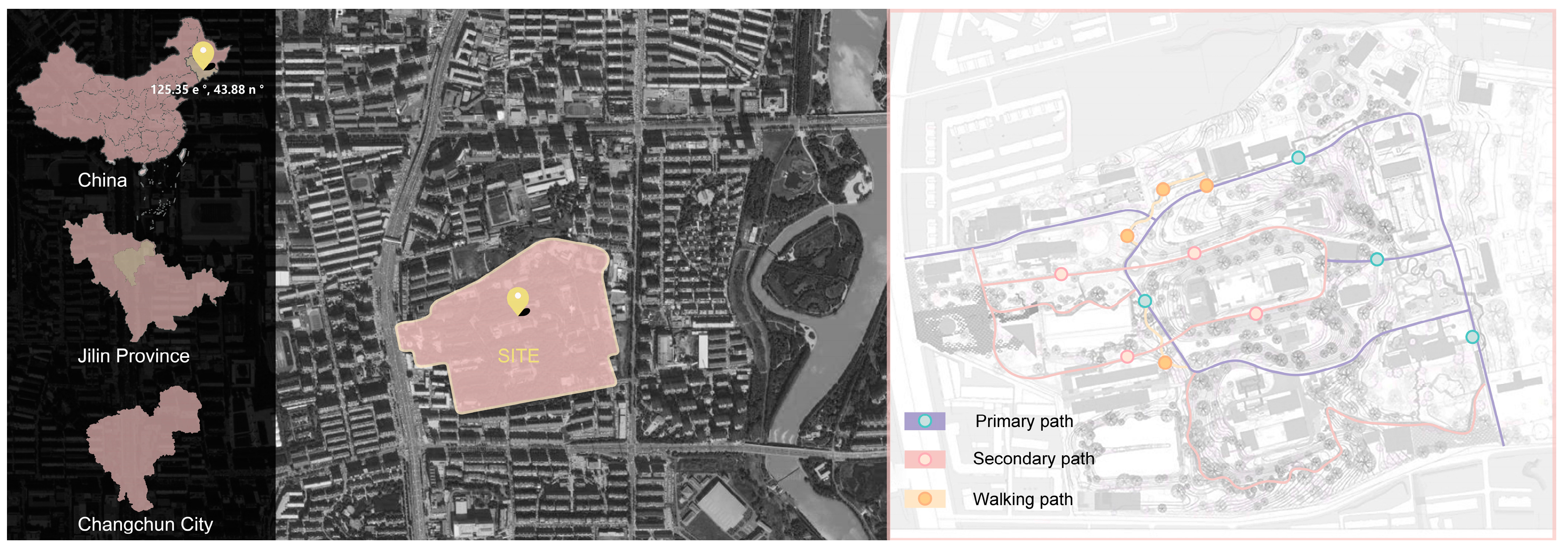

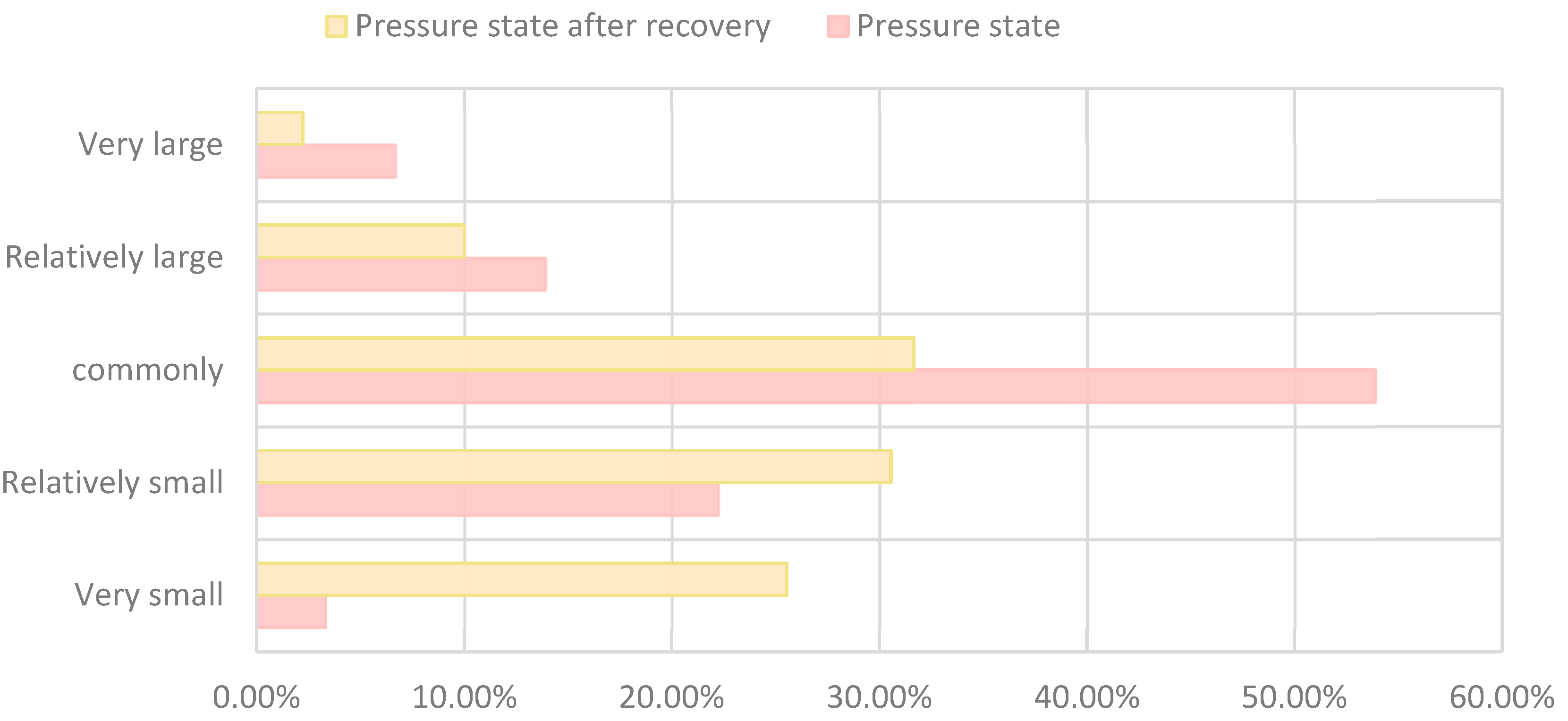
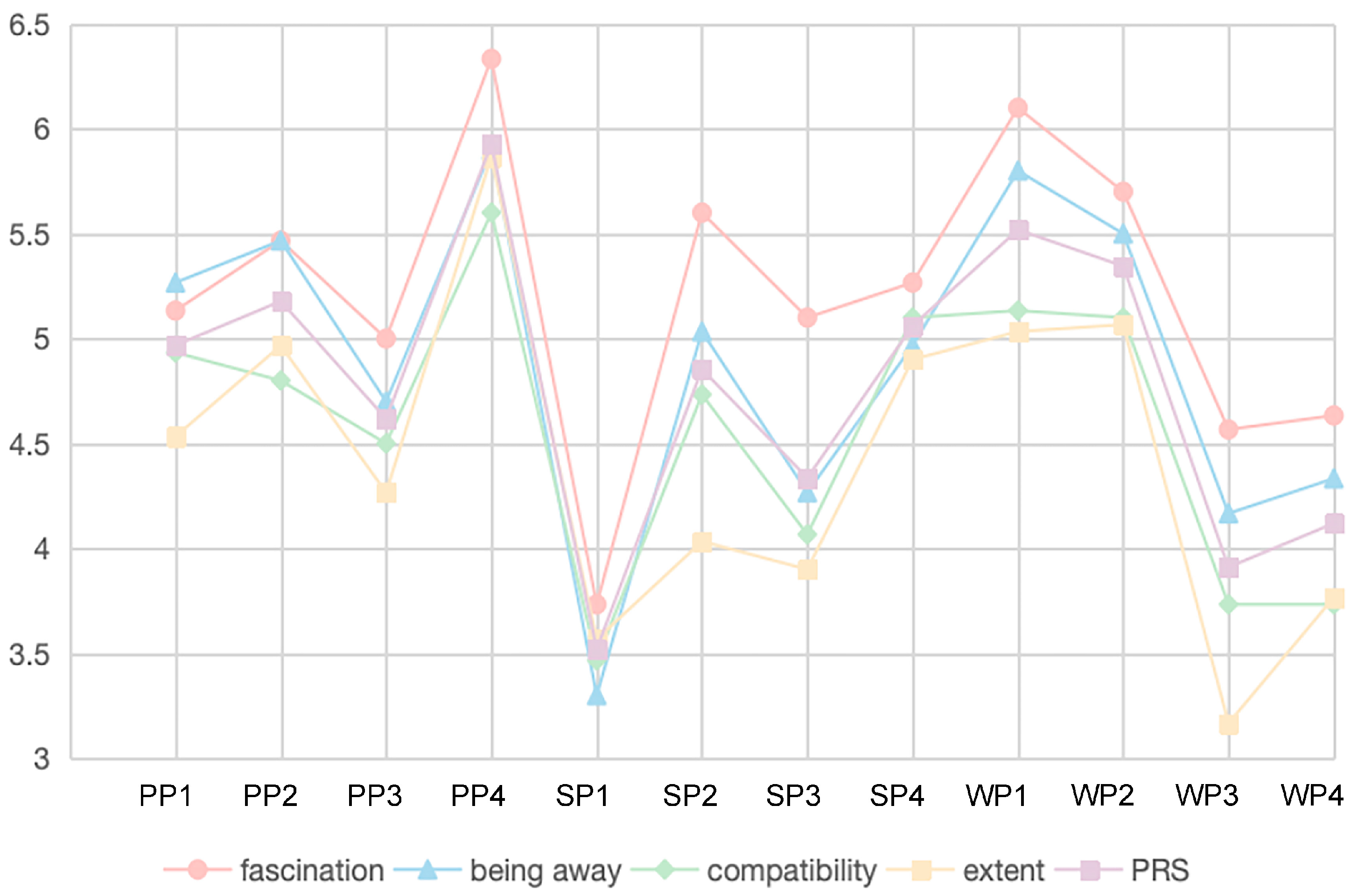
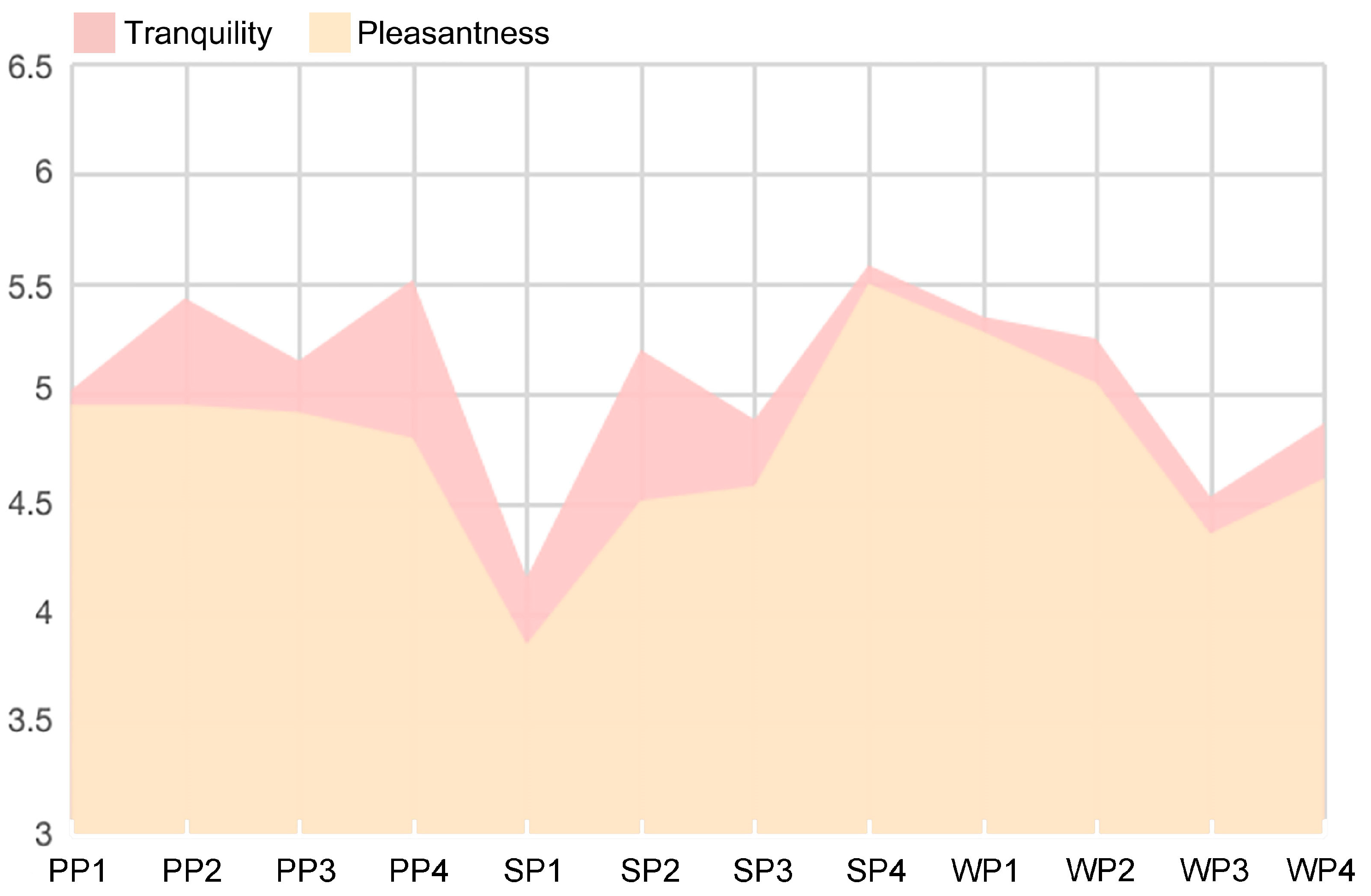
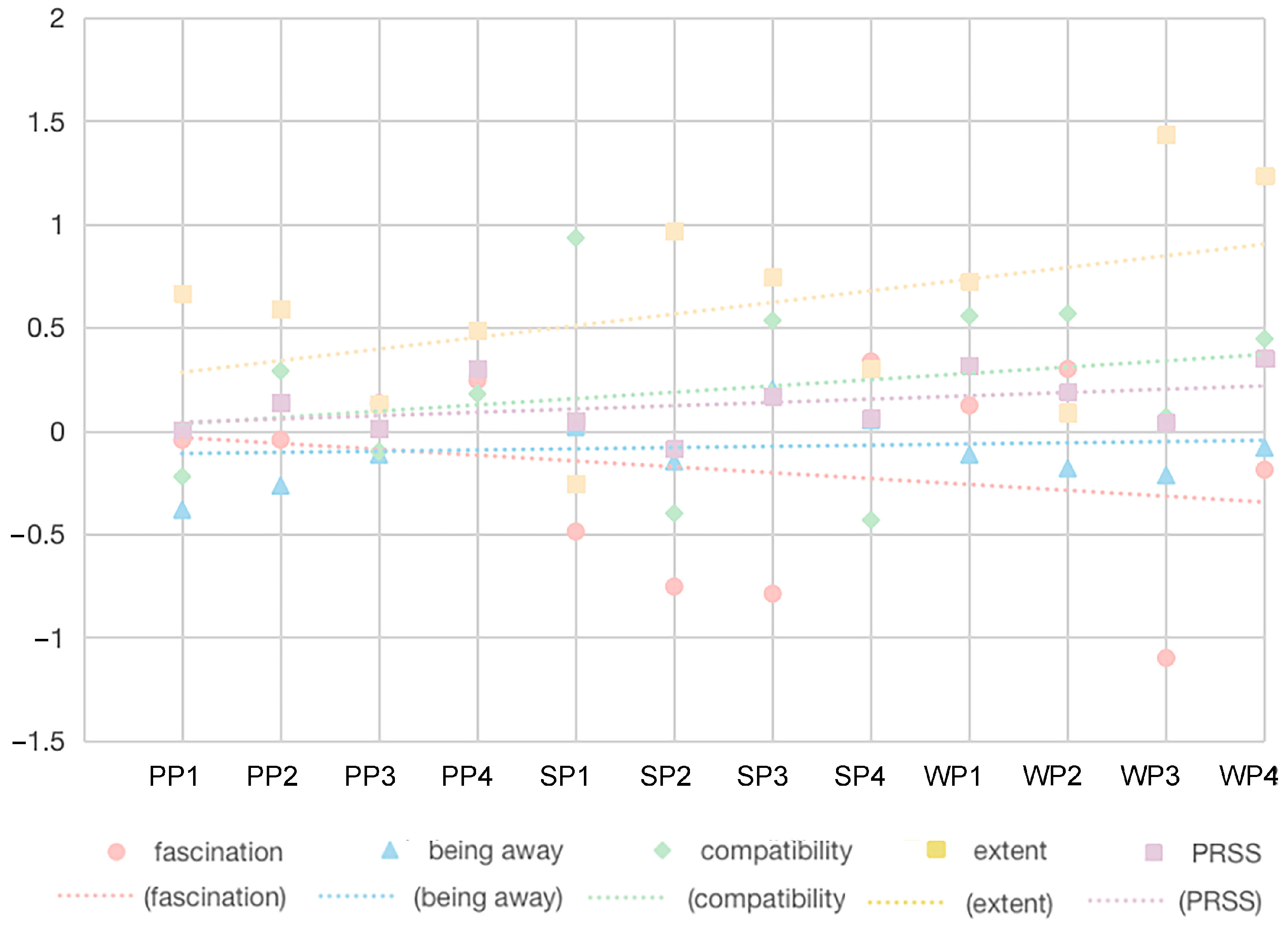
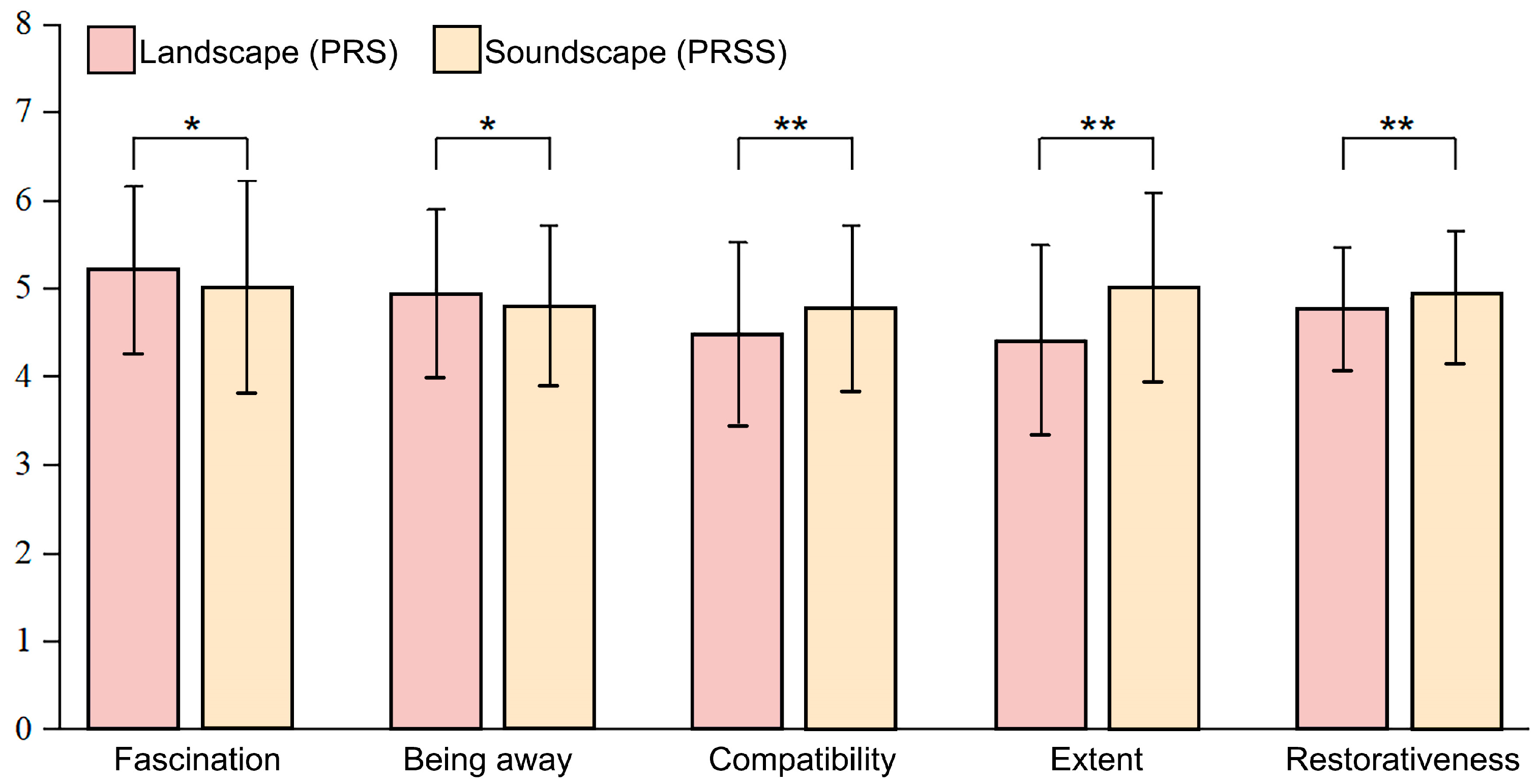
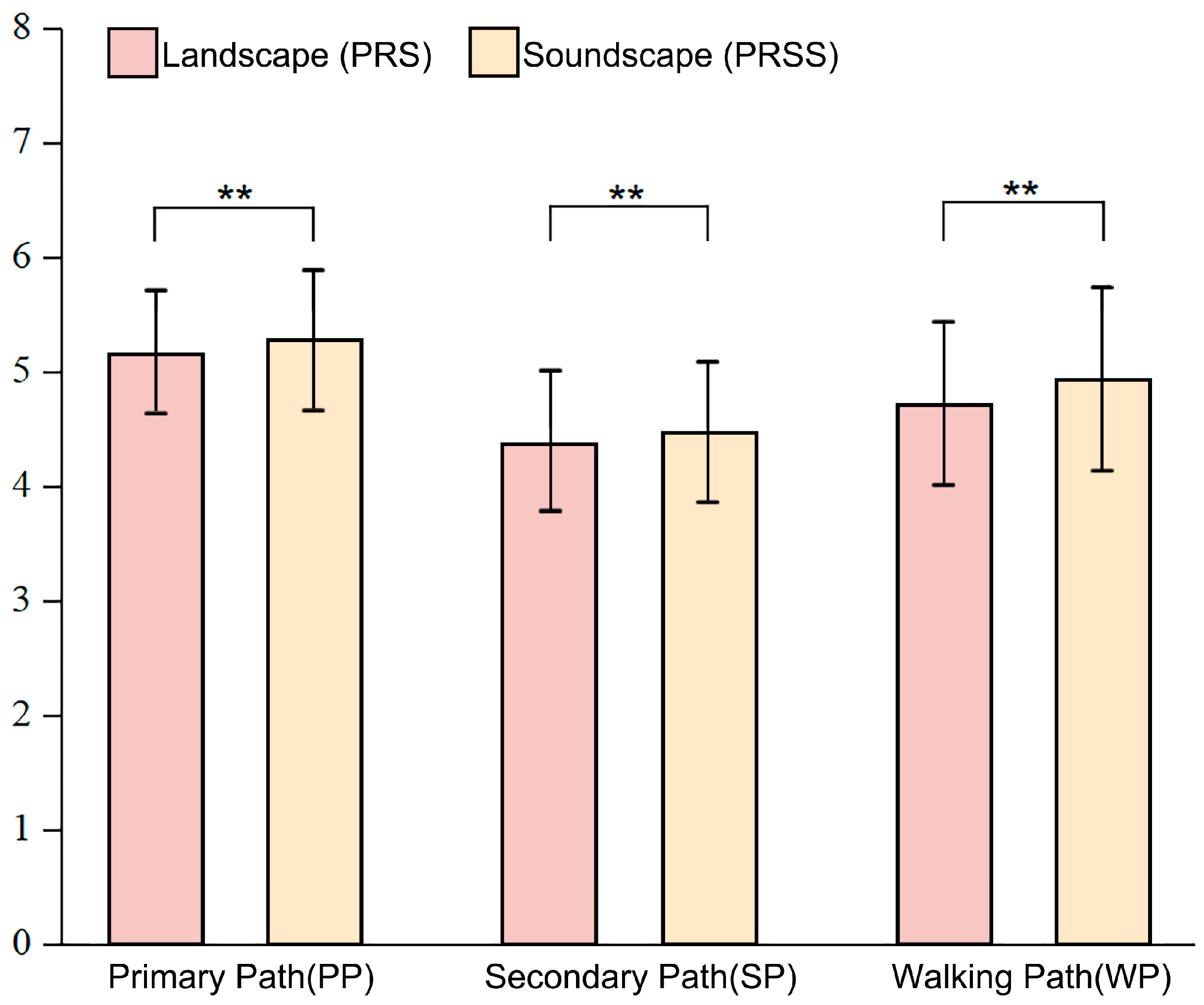

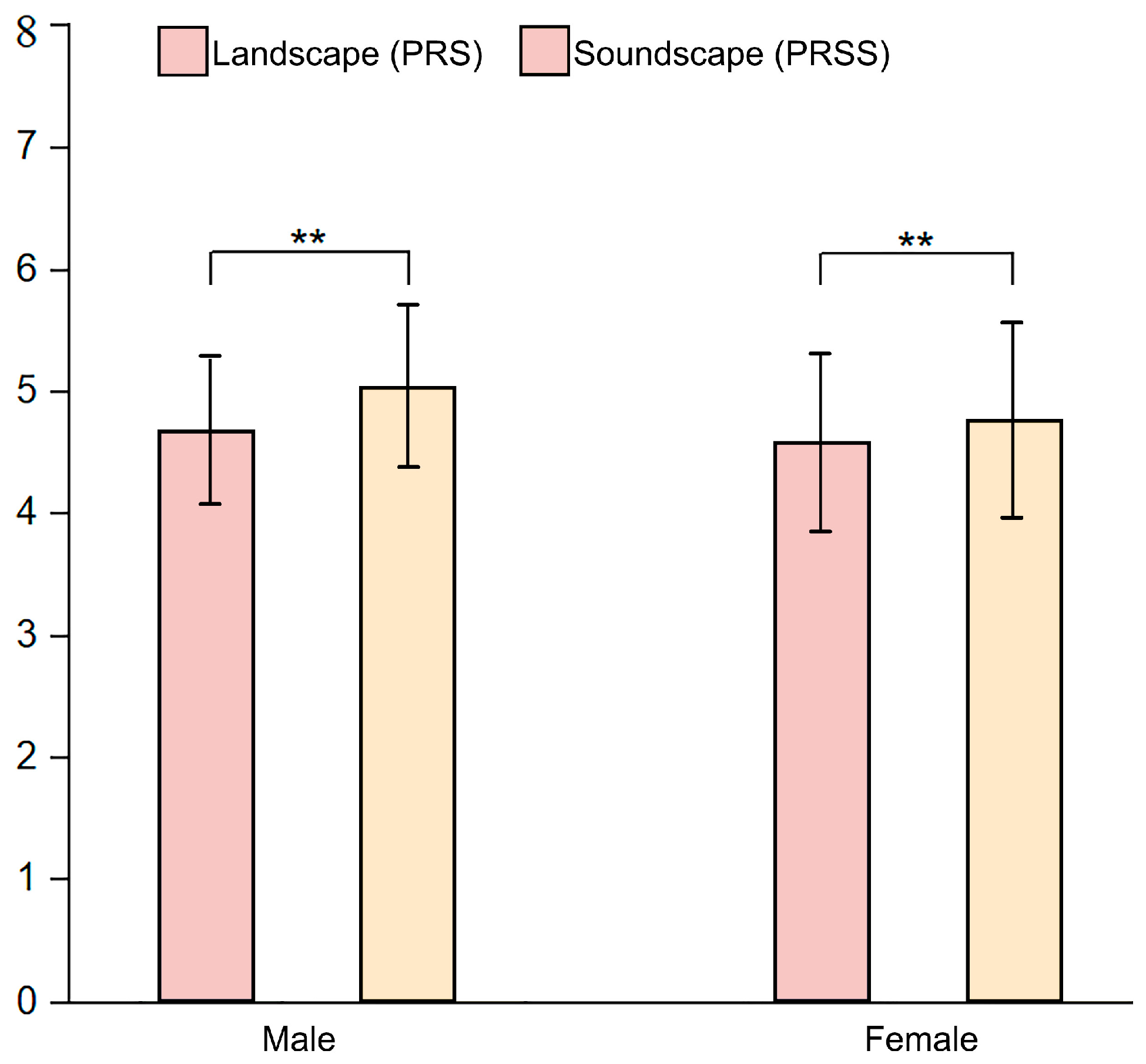
| Components | Restorative Experience with the Soundscape | Items |
|---|---|---|
| Fascination | The appeal of the environment | I find this acoustic environment appealing. |
| In this place my attention is drawn by many interesting sounds. | ||
| I am engrossed in this acoustic environment. | ||
| Being away | A sense of relaxation | When I hear these sounds, I can do something different than usual. |
| This acoustic environment is different to what I usually hear. | ||
| This acoustic environment is a refuge from unwanted distractions. | ||
| I feel free from routine and responsibility in this acoustic environment. | ||
| Compatibility | Exploration of characteristics | This acoustic environment fits with my preference. |
| I can quickly get used to this type of acoustic environment. | ||
| Hearing these sounds hinders what I want to do here. | ||
| Extent | An intoxicating environment | All the sounds I am hearing belong here. |
| All the sounds merge to form a coherent sonic environment. | ||
| The acoustic environment suggests that the size of this place is limitless. |
| Variable Name | Fascination | Being Away | Compatibility | Extent | PRS |
|---|---|---|---|---|---|
| Sky index | −0.126 | −0.206 ** | −0.080 | −0.044 | −0.165 * |
| Snow | 0.303 ** | 0.353 ** | 0.206 ** | 0.236 ** | 0.428 ** |
| Service facilities | −0.281 ** | −0.264 ** | −0.104 | −0.127 | −0.281 ** |
| Evergreen plants | −0.250 ** | −0.285 ** | −0.286 ** | −0.223 ** | −0.382 ** |
| Tree branches | 0.286 ** | 0.349 ** | 0.326 ** | 0.212 ** | 0.400 ** |
| Variable Name | Fascination | Being Away | Compatibility | Extent | PRS |
|---|---|---|---|---|---|
| Tranquility | 0.370 ** | 0.344 ** | 0.320 ** | 0.256 ** | 0.415 ** |
| Pleasantness | 0.336 ** | 0.249 ** | 0.249 ** | 0.248 ** | 0.353 ** |
| Variable Name | Fascination | Being Away | Compatibility | Extent | PRS/PRSS | |
|---|---|---|---|---|---|---|
| Environmental exposure duration | Correlation coefficient (Soundscape) | 0.477 ** | 0.490 ** | 0.277 ** | 0.354 ** | 0.551 ** |
| Correlation coefficient (Landscape) | 0.388 ** | 0.466 ** | 0.454 ** | 0.422 ** | 0.623 ** | |
| Term | c Total Effect | a × b Intermediary Effect Value | a × b (Boot SE) | a × b (p Value) | a × b (95% BootCI) | c′ Direct Effect | Inspection Conclusion | Effect Proportion |
|---|---|---|---|---|---|---|---|---|
| Sky ≥ Tranquility ≥ PRS | −8.195 ** | −4.119 | 0.126 | 0.000 | −0.805~−0.310 | −3.233 * | Partial mediation | 50.267% |
| Sky ≥ Pleasantness ≥ PRS | −8.195 ** | −0.109 | 0.047 | 0.021 | −0.110~0.079 | −3.233 * | No significant mediating effect | 0% |
| Sky ≥ time ≥ PRS | −8.195 ** | −0.734 | 0.048 | 0.000 | −0.206~−0.018 | −3.233 * | Partial mediation | 8.957% |
| Snow ≥ Tranquility ≥ PRS | −5.548 ** | −0.416 | 0.037 | 0.000 | −0.145~−0.002 | −3.292 ** | Partial mediation | 7.503% |
| Snow ≥ Pleasantness ≥ PRS | −5.548 ** | −0.057 | 0.027 | 0.038 | −0.063~0.050 | −3.292 ** | No significant mediating effect | 0% |
| Snow ≥ time ≥ PRS | −5.548 ** | −1.782 | 0.096 | 0.000 | −0.447~−0.064 | −3.292 ** | Partial mediation | 32.124% |
| Service facilities ≥ Tranquility ≥ PRS | −125.743 ** | −5.177 | 0.046 | 0.000 | −0.182~−0.004 | −108.644 ** | Partial mediation | 4.117% |
| Service facilities ≥ Pleasantness ≥ PRS | −125.743 ** | −0.646 | 0.030 | 0.000 | −0.069~0.055 | −108.644 ** | No significant mediating effect | 0% |
| Service facilities ≥ time ≥ PRS | −125.743 ** | −11.276 | 0.117 | 0.000 | −0.392~0.068 | −108.644 ** | No significant mediating effect | 0% |
| Evergreen plants ≥ Tranquility ≥ PRS | −9.713 ** | −0.743 | 0.153 | 0.000 | −0.652~−0.054 | −5.487 ** | Partial mediation | 7.649% |
| Evergreen plants ≥ Pleasantness ≥ PRS | −9.713 ** | −0.098 | 0.131 | 0.453 | −0.310~0.224 | −5.487 ** | No significant mediating effect | 0% |
| Evergreen plants ≥ time ≥ PRS | −9.713 ** | −3.385 | 0.349 | 0.000 | −2.078~−0.713 | −5.487 ** | Partial mediation | 34.851% |
| Tree branches ≥ Tranquility ≥ PRS | −8.715 ** | −0.742 | 0.109 | 0.000 | −0.466~−0.036 | −5.445 ** | Partial mediation | 8.515% |
| Tree branches ≥ Pleasantness ≥ PRS | −8.715 ** | −0.095 | 0.089 | 0.287 | −0.213~0.152 | −5.445 ** | No significant mediating effect | 0% |
| Tree branches ≥ time ≥ PRS | −8.715 ** | −2.433 | 0.259 | 0.000 | −1.229~−0.207 | −5.445 ** | Partial mediation | 27.911% |
| Gender (Mean ± Standard Deviation) | F | p | ||
|---|---|---|---|---|
| Male (n = 89) | Female (n = 91) | |||
| PRS | 4.96 ± 0.61 | 4.59 ± 0.73 | 13.687 | 0.000 ** |
| PRSS | 5.05 ± 0.67 | 4.77 ± 0.80 | 6.540 | 0.011 * |
Disclaimer/Publisher’s Note: The statements, opinions and data contained in all publications are solely those of the individual author(s) and contributor(s) and not of MDPI and/or the editor(s). MDPI and/or the editor(s) disclaim responsibility for any injury to people or property resulting from any ideas, methods, instructions or products referred to in the content. |
© 2023 by the authors. Licensee MDPI, Basel, Switzerland. This article is an open access article distributed under the terms and conditions of the Creative Commons Attribution (CC BY) license (https://creativecommons.org/licenses/by/4.0/).
Share and Cite
Bao, Y.; Gao, M.; Zhao, C.; Zhou, X. White Spaces Unveiled: Investigating the Restorative Potential of Environmentally Perceived Characteristics in Urban Parks during Winter. Forests 2023, 14, 2329. https://doi.org/10.3390/f14122329
Bao Y, Gao M, Zhao C, Zhou X. White Spaces Unveiled: Investigating the Restorative Potential of Environmentally Perceived Characteristics in Urban Parks during Winter. Forests. 2023; 14(12):2329. https://doi.org/10.3390/f14122329
Chicago/Turabian StyleBao, Yu, Ming Gao, Chunli Zhao, and Xudan Zhou. 2023. "White Spaces Unveiled: Investigating the Restorative Potential of Environmentally Perceived Characteristics in Urban Parks during Winter" Forests 14, no. 12: 2329. https://doi.org/10.3390/f14122329
APA StyleBao, Y., Gao, M., Zhao, C., & Zhou, X. (2023). White Spaces Unveiled: Investigating the Restorative Potential of Environmentally Perceived Characteristics in Urban Parks during Winter. Forests, 14(12), 2329. https://doi.org/10.3390/f14122329










